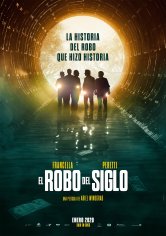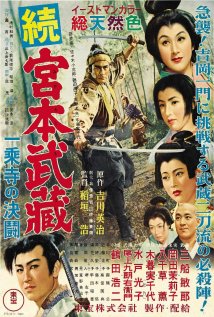Samurai II: Duel at Ichijoji Temple (1955)
Rayting:
7.4/
10 5.7K votes
Language: Japanese
Release date: 12 July 1955
Musashi Miyamoto returns to Kyoto after years of absence. After a series of fights against the Yoshioka School, he challenges its master to a duel.
Similar Movies
8.3

Major 2022
7.8

Thirteen Lives 2022
8.8

Shershaah 2021
8.2

Malik 2021
5.3

Gunjan Saxena: The Kargil Girl 2020
7.6

Tanhaji: The Unsung Warrior 2020
7.2

The Heist of the Century 2020
6.7

The Aeronauts 2019


User Reviews
Samurai II: Duel at Ichijoji Temple is the second part of the so-called Samurai trilogy by Inagaki Hiroshi about legendary historical figure Miyamoto Musashi who was a highly accomplished samurai who wasn't only a great fighter but also an intellectual philosopher and a skilled artist. This movie shows how a young ronin travels the country for enlightenment and training for several years to become an accomplished samurai.
The main plot of the movie focuses on Miyamoto Musashi challenging a martial arts school. He also meets respectable opponent Sasaki Kojiro who he will eventually fight in the last film. His relationship with Otsu is further explored as she patiently waits for his destiny to be fulfilled.
In comparison to the first movie, this sequel has more fight scenes that are quite dynamic, epic and tense. The movie starts with an impressive duel and ends with a fight between Miyamoto Musashi on one side and eighty martial arts school students on the other side. The film has an overall quicker pace than the first part and is thoroughly entertaining.
All beloved characters from the first movie are back in the sequel and Mifune Toshiro's acting skills are once again quite impressive even though he seems to be acting too impulsively at times to portray a character who has undergone changes to find peace of mind. Mifune Toshiro fits the role much better in the energetic first film and accomplished third movie of the trilogy.
The main reason why this movie is the weakest part of the trilogy is because it skips three years in the life of Miyamoto Musashi and fails to tell how the protagonist has changed. This is even more inappropriate regarding the side characters. The last time we saw the protagonist's childhood friend Matahachi, he was engaged to Otsu but had parted with beautiful Akemi and her manipulative mother Oko to protect them against bandits. Three years later, he has suddenly married Oko who is though having a romantic relationship with Toji who works for a wealthy martial arts school owner whom he expects to marry Akemi and hopes to make lots of money in the process. It's never explained how Oko and Matahachi got married, how their relationship failed and how Toji met the unstable trio.
Despite a few plot holes and some lack of character development, it's essential to watch Samurai II: Duel at Ichijoji Temple as a link between the energetic first film and the accomplished third movie. This second part is still entertaining with its wonderful cinematography, improved fight scenes and plot filled with sinister intrigues. Don't jump on the tiring Game of Thrones bandwagon and watch this movie instead which offers similar contents with more style.
Fmovies: OK. First of all, I am huge Toshiro Mifune fan. I am also a huge...and I mean huge Musashi fan. And lastly I have seen plenty of Samurai films. But I have watched Samurai 2: Ichijôji no kettô twice now, and I just can't stomach it. It is perhaps one of the most clichéd samurai films I have ever seen. The story seems to be based on the mystical Miyamoto Musashi, rather than a more realistic character. In addition, there is so much thick, syrupy melodrama and love triangles that it really hinders the story from flowing well. Not to mention it often takes away energy from some of the action scenes.
Mifune really makes this film bearable. Koji Tsuruta as Kojiro Sasaki is also outstanding and commands plenty of respect on screen. However, some of the other actors are mediocre at best.
There is much to be said about old Samurai cinema, and the way they glorified and really elevated these noblest of warriors. But Ichijôji no kettô just covers it in a thick melodramatic goo and wraps it in toilet paper.
In addition, the film has very bad lighting, plenty of anachronisms, continuity problems and poor editing. Once again, Toshiro Mifune as Miyamoto Musashi is my personal hero, Jesus Christ, Lord and Savior...but was there ever! a less fitting movie for this cinematic giant.
RE-MAKE!
Being the middle film of a trilogy, Duel at Ichijoji Temple thankfully came with a lot more battle sequences than the first film, and had more finesse in its swordplay since our legendary heroic character Takezo (Toshiro Mifune) is now a skilled swordsman, but yet to put into practice many aspects of Bushido, and often criticized in the manner in which he finishes off his opponents because of his innate brute strength and force.
But I guess when you're top dog, criticism comes part and parcel, and in his warrior pilgrimage in discovery of skill and self, we see how he further develops, though at time I felt that the story utilized a cheat sheet just like the first film, where priest Takuan (Kuroemon Onoe) locked him in a castle with plenty of books. Here, while Takezo is in hiding, he spends plenty of time indoors under the patronage of Lady Yoshino (Michiyo Kogure), a courtesan who would inculcate some compassion into the gruff man's life - while he looks refined on the outside, his ambition and reputation continue to earn him no favours, especially since he had issued a challenge to the Yoshioka School.
As a middle film, it expanded the mythology, and further developed the characters who made teasing appearances in the first one. For instance, the young man who was smitten by Akemi (Mariko Okada) turns out to be none other than the leader of the Yoshioka School, Seijuro Yoshioka (Akihiro Hirata), who in a fit of envy began to violate Akemi, taking his ineptness onto a helpless girl. Such are incidents that make the character a little revolting, and the members of his school showcased to be nothing more than mere bullies to the townsfolk, as well as constantly sucking up to Seijuro by shielding his incompetence from the real world.
The villains in this installment turn out to be more formidable than the thugs and brigands that Takezo had to deal with earlier. In fact, the first duel was a battle with an opponent using a chain-and-sickle, in compensation for the lack of a swordfight as a climax in the first film. Unfortunately I found this to be mildly exciting, as the full screen presentation only allowed for that fatal blow to be delivered off screen. The middle duel with Denshichiro Yoshioka was also somewhat of a let down given the buildup, because it only allowed a brief clashing of the weapons, before director Hiroshi Inagaki decided to cut away to a song! It felt like a little short-change, though the result of the match was made known indirectly later.
And the expansion of the characters here only made the story richer. Familiar faces like Takezo's lover Otsu (Kaoru Tachigusa) returns to pine a lot more for him after 3 years of waiting, while her ex-fiancé Matahachi (Sachio Sakai) degenerates worse in character, into a good for nothing liar and a cheat, married to Akemi's scheming mom Oko (Mitsuko Mito). We also get introduced to sword polisher Hanomi (Ko Mihashi) who's supposed to play an influential role in swaying Takezo's mindset, though the narrative here didn't allow too much of that on screen, deflecting it towards Lady Yoshino, for yet another romantic entanglement, where the female characters are all weak in their knees in Takezo's manly presence.
But the most important character introduced in the film would be Kojiro Sasaki (Koji Tsuruta), the eventual nemesis of Takezo's, but you've got to wait until the next film to see them do battle. Here, Kojiro's like the predator, slowly studying and stalking his prey. We know little of h
Samurai II: Duel at Ichijoji Temple fmovies. This comment about the "Samurai Trilogy" starts on the page for Miyamoto Musashi (Samurai I). My first viewing of the second episode was memorable because I got to take the train into town all by myself, and view it in a Tokyo theater. The first episode had just been shown on base, in a sort of cultural exchange, and my parents saw it and were pleasantly non-outraged-- I was a 9-year-old samurai-movie addict, and they believed enthusiasm beyond a certain intensity should be curbed. It was the same conflict as comic books some few years earlier. Technicolor was a big deal back then, especially in Japan, and it became the issue on which my viewing of "swordfighting movies" was decided-- the ones in color were historical films worth viewing, and even had something to teach. The black-and-white ones shown in Irumagawa and surrounding villages-- I had to sneak off to see. Ichijoji no Ketto (Duel at Ichijoji Temple) shows Miyamoto-san's achievements, while barring no holds on the issue of what they cost him. The romantic subplot continues, though its development in the western sense (toward union, wedded bliss) is thwarted at every turn. The issue is always a conflict between love and duty, and each deferment of gratification spells out a new step in the redefinition of the national character that is being mapped here. Again, some of the importance of all this is lost, even to modern Japanese audiences for whom the issues are long settled-- at the time, though, they were cliffhangers. A new character is introduced, Kojiro Sasaki who will emerge in part 3 as a rival for Musashi-- his equal except for certain features in their respective character. By the way, the score is excellent and haunting-- it extends like a symphony through all three parts, and has a leitmotif "hook" that will cause your ears to pick up in recognition, perhaps years from now, when you hear it again.
I've watched the entire trilogy of the Musashi Miyamoto films, of which this film is the second part. The first film, titled simply "Musashi Miyamoto," introduces us to the characters of this and the third film. Without having seen the first film and developing some interest in the welfare of the characters, I certainly wouldn't have sat through the second and third films.
"Duel at Ichijoji Temple," this film, deals with Musashi's exploits as a sort of samurai knight-errant, seeking glory in a very ambiguous and roundabout way. Two women are trailing after him, as Kurosawa films would say, "like goldfish dung." Musashi himself is a flat character on whom Toshiro Mifune's acting skills are wasted. He displays very little emotion or intellect, despite his supposed interest in one of the women and enlightening education by his monk teacher (as we saw in the first film).
If Musashi is flat, the female characters are steamrolled. Their hand wringing, collapsing, and sobbing is typical of American movies of this time period and grows tedious in a samurai film. Having seen other films from this time period set in the days of samurai, I've seen that much more can be done with female characters. The plot was likewise predictable and slow-moving.
If you don't care about characters or plot, the high points of the movie may compensate: beautiful color landscapes and Toshiro Mifune's thrilling fight scenes. Otherwise, I recommend films by Kurosawa or Mizoguchi ("Sanjuro," the mysterious "Ugetsu") over this trilogy. 5/10
The first part of the trilogy was setting up the story, visually resplendent but leaves you out in the open. In this second part the direction is solidified. Musashi is set up to choose between the way of the sword or love for the girl Otsu, while having to face his nemesis, foreshadowed for the closing chapter.
What puts me off this second chapter, which I rate the lowest of the three, is that we had a set of characters in the first film, and suddenly we have another set of characters. The film revolves around his feud with the Yoshioki school.
So in a way, this loose narrative foreshadows the third chapter. As it emerges in this second film, the film is not one long epic split in three parts. Neither is each of these first two films self-enclosed. The narrative is a loose stitching together of episode and digress, thrust and feint in many directions; observant viewers will notice the same in the elliptical shooting mode.
I will not say more about this as a film since we are still halfway there, instead let's look at some context around the film, here on the fluidity of self.
--
This is a core precept of Buddhism, which features prominently in the films; Musashi receives key lessons by monks, his journey is one of self-realization, internal abating of ego.
This fluidity is seen in the transmission and establishment of Buddhism in Japan over several hundred years through several attempts, several travels of Japanese monks in China. Both notable Zen schools in Japan were initiated by monks of the Tendai sect who had been to China. The film's main two centerpieces take place outside Buddhist temples (one is referenced in the title, the other is Sanjusangen-do), both belonging to Tendai. The Sanjusangen-do, a marvelous structure, is also famous for housing one thousand and one statues of the thousand armed Kannon, the boddhisatva of compassion. The little wooden statuette that Musashi is seen carving in spots is of Kannon.
Now simply saying that the self is illusory sounds weird, metaphysical or philosophical at best. Buddhists have many of the same lofty words as we do, about 'void' and 'self', but whereas we're accustomed to theoretical construction and analytical philosophy (we love words in the West), they resort to words as a last means of describing a practice—also evident in Musashi's own writings where he stresses experiential appreciation.
So when they say 'void', they don't mean a generality but something which can be felt, has been felt, as one feels the temperature of water. When they say 'self', they mean when a single thought arises while you're washing the dishes.
It's a pain in the ass to talk of it, because how can you say exactly how warm it is? It either is to you or isn't. Stick your hand in. Zen Masters (as well as Musashi whose 'Way of strategy' is Zen-flavored) knew this, which is why they loved paradox, urged silence or beat and kicked their students when they asked logical questions. The point is to know for yourself. A similar thing happens to Musashi in the first film when he is tied by a Zen monk from a tree, a fictional event.
This monk, Takuan, existed; though his interactions with Musashi in the film are fiction, presumably he did know Musashi. He wrote on this business of illusion and nonself using sword metaphors, because the writings were intended for Yagyu Munenori, sword instructor to three shoguns and with Musashi the most famous swordsman